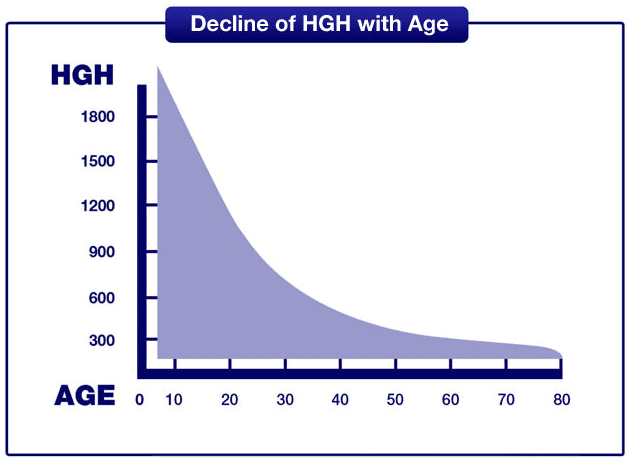Four Tests That Will Tell You The Truth About Your Health
Hey, you lean, mean fighting machine… do you still have that old glide in your stride, and muscles bulging everywhere! No worries, eh? Well, when’s the last time you had a blood, saliva, urine or hair test to check on your biochemistry, particularly your hormones? Might not be so rosy inside, as I discovered.
 [Source]
[Source]
HAVE YOU ever seen that cartoon picture of some old, fat guy looking in a mirror and what he sees reflected back to him is some youthful stud?
Here’s one example:
My guess is that you don’t suffer from such delusions, but you know what… you may have no idea about what’s brewing inside you that may surface one day to confuse and batter you.
Most of us can see reality in the mirror in all its living color. What we don’t see quickly enough is what’s up with our human growth hormone, testosterone/estradial balance, thyroid function, adrenal gland/cortosol function, insulin sensitivity/glucose, and the like. These are among the biochemical metrics that determine our health and vitality, and they all get challenged as we age.
Hell, human growth hormone has already done a deep dive before we’re twenty!
My point is that you need to find out what’s brewing inside. You need to find out the truth about your health.
Frankly, I was shocked to discover some unpleasant truths about my own biochemistry, which I’ll reveal in a minute.
In an ideal world, you could put your finger on your smart phone’s camera and in five seconds know everything about what’s happening inside yourself, such as:
– What’s going on with my hormones?
– What’s my body fat percentage?
– How are my cholesterol numbers doing?
– Is my blood sugar nudging me into the diabetic range?
Someday, maybe a smart phone will do this, but not today… today we have blood, saliva, urine and hair tests that yield important information about what’s going on inside of you. You might have a clue that something’s amiss. But what is it?
For instance, have you ever checked out the symptoms for low testosterone? It’s reasonable that you might, because testosterone levels in many men and women begin to decline as early as the third decade. But are those symptoms you’re experiencing due to low testosterone or something else? Turns out, many of these symptoms are shared by an under-active thyroid (hypothyroidism).
So, if you’re experiencing fatigue, low sex drive, mental fogginess and have gained weight… is the problem your thyroid or testosterone?
Which is it… or is it both?
You need a hormone test, or a diabetes test — some kinda test — to find out, perhaps a more one more comprehensive than what’s offered by your health plan.
I’ll give you a reason by way of example.
I’m the example.
Blood Tests
In July of 2012 I got a blood test via the Life Extension Foundation (“LEF”). This was much simpler than I expected. What I had to do was to:
- Use LEF’s handy search to find a blood factory (actually, a better name is “blood lab testing center “) close to where I live that partners with them;
- Make an appointment in the lab’s online scheduler;
- Show up on the right day and time:
- Extend an arm, exposing a vein;
- Flirt with the Phlebotomist (aka vampire who inserts the needle, etc.) to distract myself from the X ounces of blood filling up the test tubes; and
- Go home to wait for the results.
Whilst I waited, the blood factory sent the test tubes to various labs contracted by LEF, reported the respective results to LEF, which then summarized them in a report sent to me in about a week.
Yes, to the uninitiated, the report may be difficult to decipher, but you can call an LEF expert to review it with you, which I did.
Mine was a pretty comprehensive blood panel and tested a bunch of things, but I want to focus on here are the cholesterol numbers.
If you read health news stuff, you may know that there’s a raging debate about cholesterol these days, even among medical scientist types. It used to be that the higher was your total cholesterol, the worse off you were, and doctors and pharmaceutical companies would scream, “statins, statins, statins”.
Nowadays, various pundits are saying that “high” total cholesterol isn’t bad… what you should watch out for is high LDL, or “Low Density Lipoprotein”, a component of cholesterol.
Well, we always knew that LDL needs to be “low”, and that HDL (“High Density Lipoprotein”) needs to be “high”, but we also used to think – and some medical types still do – that the total of these two – Total Cholesterol – should be low if we’re to avoid plaque build up in our arteries that could lead to various cardiovascular ills of the heart attack variety.
Personally, I don’t have a dog in this fight, simply because I don’t know enough about dogfights, or cholesterol even. But what is clear is that, yes, HDL should be high, ideally at or above 60 milligrams per deciliter (“mg/dl”), and LDL should be low, ideally at or below 99 mg/dl, according to LEF..
(Note: I’m already in the doghouse, as we’ll see.)
That said, different organizations/doctors argue for different ideal targets and acceptable ranges (“Reference Intervals”).
The 60 mg/dl for HDL and 99 mg/dl for LDL are LEF targets; however, the Mayo Clinic is more liberal (meaning, you can get away if more lousy numbers), and puts HDL at 40-49 mg/dL (men), 50-59 mg/dL (women), and LDL between 100-129 mg/dL (all) for people not at risk for heart disease. (Source)
Here are the Cholesterol test results of my 2012 LEF blood panel:
| Test | Result/Unit | Reference Interval |
| Cholesterol, Total | 162 mg/dl | 100-199 |
| HDL Cholesterol | 51 | Above 39 |
| LDL Cholesterol | 97 | 0-99 |
| Total/HDL Ratio | 3.2 | 0-5 |
Doctors often use a few ratios used to get a better sense of heart disease risks. Total Cholesterol divided by HDL is one such ratio, and it’s presented on my LEF blood test results, along with this statistical imprint:
Total Cholesterol/HDL Ratio
|
Risk |
Men |
Women
|
|
½ Average Risk |
3.4 |
3.3 |
|
Avg. Risk |
5.0 |
4.4 |
|
2x Avg. Risk |
9.6 |
7.1 |
|
3x Average Risk |
23.4 |
11.0 |
So, despite the fact that I’d like to have had a higher result for HDL and lower for LDL, my Total Cholesterol/HDL Ratio of 3.2 is below ½ the average risk, and I was content.
Unfortunately, these numbers do not paint a full picture. A full picture, it turns out, required more details and underscores the need to test your health rigorously.
Fast forward to LEF blood test done in August of 2013. For no other reason that I’m a bit wonky on matters of health, I decided to go add the VAP test to the blood panel.
“VAP” stands for “Vertical Auto Profile” (don’t ask), and it tests for more cholesterol particles, and at a more refined level, than standard tests, such as these:
- A more accurate, direct measurement of LDL.
- Measurement of LDL pattern density, important because small, dense LDL (“Pattern B”) triples the likelihood of developing coronary plaque and suffering a heart attack.
- Measurement of lipoprotein subclasses, which include HDL2 and HDL3, intermediate-density lipoprotein (IDL), very-low-density lipoproteins (VLDL1, VLDL2, VLDL3), and other lipoproteins that can lead to heart attacks and strokes.
Here are a few of the VAP Cholesterol results of my 2013 LEF blood panel:
| Test | Result/Unit | Reference Interval |
| Cholesterol, Total | 167 mg/dl | Less 200 |
| HDL Cholesterol | 53 mg/dl | Above 40 |
| LDL Cholesterol | 97 mg/dl | Less 130 |
| Total/HDL Ratio | 3.2 | 0-5 |
| VLDL | 17 mg/dl | Less 30 |
| HDL -2 (most protective) | 9 mg/dl | Greater 10 |
| VLDL-3 (small remnant) | 10 mg/dl | Less 10 |
| LDL Density Pattern | B | Abnormal |
Yes, everything was looking rosy as long as the 2013 test measured what it did in 2012, but thanks to the details of the VAP test, I discovered that I might have some issues; namely:
- HDL-2, at 9 mg/dl is too low, which could indicate susceptibility to coronary artery disease.
- VLDL-3, at 10 mg/dl, is too high and could indicate susceptibility to type-2 (adult-onset) diabetes, which my father and uncle had.
- A LDL Density Pattern of “B” means the LDL cholesterol “balls” are small and dense, which could rupture arterial walls (think those air gun BBs), rather than the “fluffy” Patter “A” LDL, which is far less damaging.
All this made me rather unhappy, but it made me investigate things I would never have known about without this VAP blood test. Metaphorically speaking, I was the fat guy smiling at the reflected image of his false glorious self. In my case, the outside (phenotype) looked fine, but something was amiss on the inside.
Since my diet contains little to none of the food and drink thought to cause high LDL numbers and subparticles, I had to dig deeper, and discovered that what may be behind these pernicious test results are rather high fasting blood glucose numbers and systemic inflammation. And that what might be causing that is a low functioning thyroid and too much mercury in my body.
So, you see, it’s like a ball of yarn that drops from your hands and unravels, bouncing down the stairs, and you have no other option than to follow where it leads. I’m still chasing my yarn and will report my findings once I find out what’s going on.
Things may be going on inside you that have yet to manifest in a way that gets your attention. Certainly, this has been the case with me. My phenotype (physicality) suggests that I’m hale, youthful looking and strong – and overall, that’s true – but what’s lurking (perhaps growing) within that may cause health problems later?
The point is, discover the truth about your health… know your blood numbers.
Or at least your spittle.
Saliva Tests
If giving up some of your blood makes you queasy, how about some spit?
Yes, chortle your throat, work up some spittle and let it fly into some container mailed to you buy your favorite saliva tester, cap it, mail it back and soon you’ll learn quite a bit about yourself.
But are the results generated from a saliva test true, or at least as accurate as possible?
Like nearly everything in the world of health, there’s debate about what blood and saliva tests are the best at discovering and measuring. For instance, is a saliva test the best way to uncover how well your hormones are functioning?
Some medical practitioners deem saliva tests to offer a good look at what’s happening with tissue as opposed to serum blood. So, for instance, if a physician is interested in the estrogen levels within the breast or uterus, (s)he might use a saliva test.
These proponents of saliva testing to determine hormone health say that blood tests are limited in that they show only “normal” hormone levels, but may not reveal how hormones are actually affecting the body.
According to Dr. Leon Speroff’s book Clinical Gynecologic Endocrinology and Infertility, a serum measurement of steroid hormones:
- Is unable to distinguish between bound and free estrogens and testosterone
- Has a large normal range
- Provides limited clinically useful information (Source)
As mentioned, the efficacy of saliva tests is debated. The popular and avuncular Dr. Andrew Weil and his medical team have examined this topic and thinks that saliva tests for hormone levels are generally not reliable, with some exceptions.
Dr. Weil advises that hormone exceptions for which saliva tests are now considered highly reliable are:
- Testosterone,
- DHEA, and
- Cortisol.
My next test to measure various steroid hormones (such as Testosterone, DHEA, Estradiol, Progesterone) is likely to be a blood test so that I can compare apples to apples (blood to blood) given that my last two tests were blood tests.
However, if I had to start from scratch and was only interested in testing for Dr. Weil’s three above listed, I’d consider going for a saliva test if for no other reason that they’re relatively cheaper than the corresponding blood test. This becomes a significant advantage for saliva tests given that multiple tests over time are warranted to determine if whatever you’re doing to boost testosterone, etc. is working.
Do this: Once you know what you want to test, do an Internet search for the best type of test if the material presented here isn’t definitive.
And you might include urine among them.
Yeah, your urine can reveal a lot about you — and not just when you last ate asparagus.
Urine Tests
Depending on the type of urine test, you might be required to either urinate in some canister that can be tightly covered, or onto a test strip, and then mail whichever to the lab for evaluation.
A urine test checks different components of urine, a waste product made by the kidneys.
The general public knows about urine tests in the context of drug testing. Women, though, might be a bit more familiar with urine tests as they are used to test for bladder and urinary track infections, more common for them than men. It then might be surprising that urine is also commonly evaluated for more than 100 tests, among them to determine:
- Vitamin levels
- Diabetes
- pH (alkalinity/acidity)
- Bacteria, yeast or parasites, etc.
The first urine test you should take is your own. Take a pee, then take a peek… what color is it?
The Cleveland Clinic provides this infographic for our enlightenment and rumination:
May your urine be crystal clear forever.
Hair Tests
From my reading on the topic, hair tests seem to be the most controversial. There are arguments about external contamination, changes cosmetic treatment causes in hair, inconsistent laboratory processes and (strangely) ethnic bias.
A fella by the name of Dr. Lawrence Wilson has systematically delved into many of the arguments, and his post on the matter is a worthy read if you’re considering a hair test.
Irrespective of your interest in hair tests, some of Dr. Wilson’s concluding remarks in the above reference post shed light on why the various tests examined in this article may produce different results.
He says that the examiner of such tests needs to be able to interpret how different tests relate to each other by, given an understanding of their basic differences, such as:
– The hair measures a different body compartment than the blood or urine. Each has its own metabolism.
– The blood is maintained at the expense of tissues such as the hair. This means the hair will change first, often years before the blood.
– The blood is far more buffered. It has to be because it touches every cell. Large variations in mineral levels here would be fatal. This is not the case with the hair.
– The hair is a storage organ and, to some degree, an excretory tissue. The blood is a transport medium.
– Blood, urine and saliva provide short-term or even instantaneous readings, whereas a hair test provides a 3-month average or a longer-term reading.
– Homeostatic mechanisms at work in the blood such as buffering of pH and osmotic balance are extremely different from homeostatic mechanisms at work in the tissues and at the cellular level in the hair. (Source)
Confused yet?
Well, I wrote an article on this topic that may help, and it said that hair tissue mineral analysis can help anyone who:
- Is ill and doesn’t know why;
- Has identified the illness, but the therapy is ineffective; or
- Wants to improve health by identifying where some potential problems may exist as related to mineral deficiencies.
Your Takeaway
My last words here on blood, saliva, urine and hair tests come in four sentences:
- If you have medical insurance, tell your doctor what you want to test and ask him which kind he recommends.
- Make sure your doctor is focused on discovering and addressing underlying causes, not simply making the symptoms (aka pharmaceutical drugs).
- Extending from #2, ensure your doctor recognizes the potential that one hormone issue might extend from another, or from something like heavy metal contamination (mercury, lead, copper).
- Spend your own money if you have to in order to get the test you want, but recognize that mass confusion can result from trying to piece together the puzzle if your health issue is not clear cut.
To find out more about what blood tests the Life Extension Foundation offers, click this image:
So, choose a test and get the truth about your health. Even if you do look great in the mirror. You’ll be glad you did.
Over and out.
IMPORTANT DISCLAIMER
Disclaimer and Safety Information
Joe Garma is not a medical doctor, and neither he nor the information in this article — or anywhere on this website — can or should replace the attention or advice of a physician or other qualified health care professional. Anyone who wishes to embark on any dietary, drug, exercise, or other lifestyle change intended to prevent or treat a specific disease or condition should first consult with and seek clearance from a physician or other qualified health care professional.
Pregnant women in particular should seek the advice of a physician before using any protocol listed on this website. The information and protocols described on this website are for adults only, unless otherwise specified. Product labels may contain important safety information and the most recent product information provided by the product manufacturers should be carefully reviewed prior to use to verify the dose, administration, and contraindications. National, state, and local laws may vary regarding the use and application of many of the treatments discussed.
The reader assumes the risk of any injuries. The authors and publishers, their affiliates and assigns are not liable for any injury and/or damage to persons arising from this protocol and expressly disclaim responsibility for any adverse effects resulting from the use of the information container herein.
The information and protocols on this website raise many issues that are subject to change as new data emerge. No information or suggested protocol regimens can guarantee health benefits. Joe Garma has not performed independent verification of the data contained herein, and expressly disclaim responsibility for any error in literature.
Last Updated on July 7, 2023 by Joe Garma






